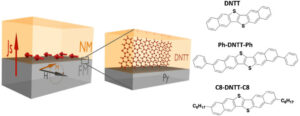A joint publication by the Organic Spintronics Team showing how key spintronic properties of organic molecules adsorbed at a solid surface may be precisely tuned by modifying the adsorbate structure has been published in Physical Review Letters.

More precisely, experiments performed by our collaborators at Cambridge University (UK), show a broadening of the electron spin resonance (ESR) linewidth upon spin injection from a permalloy surface into thin films of DNTT-based organic molecules. This broadening depends sensitively on the composition and surface bonding of the adsorbate molecules.
With the support of theoretical calculations performed by collaborators at Mons University (BE), significant differences in, e.g., the spin diffusion lengths of the organic adsorbate layers can be inferred from the measured variations in ESR linewidth.




